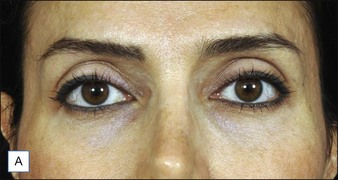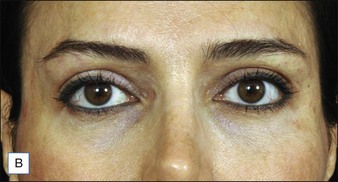15 Volumetric treatment of the brows
Summary and Key Features
• Orbits that are large, round, and hollow are associated with age, not youth
• Young orbits are almond shaped, the bone is not visible and there may be considerable fullness of the upper lid
• The same configurations that are seen in younger patients may be perceived as looking old in older ones
• Communication is difficult in the periorbital area. Many patients want the eye ‘lifted’ or skin and fat removed since that is what they have been told is done. Moreover, some patients like the hollow and defined look as it may look more dramatic and makeup can be used more liberally
• The author prefers using a trial of local anesthetic in the upper lid to demonstrate the visual effect of filling in the upper lids and brow. If the patient likes the look, the injection is done immediately; there is no need to wait. Local anesthetic provides a vasoconstricted environment. There is no better way of communicating the visual effect of the brow fill
• Putting in the local anesthetic and avoiding overfills and fluid blobs in the upper lid is difficult to do well and easily; some practice is involved. The area is massaged and a few minutes should elapse to let the local distribute before showing the patient
• Underfill is better than overfill. This is not a method to fill in an abundance of skin, though the fill does inflate some skin. Nor is it a method to lift brows, though the brow can elevate in a few patients. Someone with full heavy lids is not a candidate for this procedure
• The author favors non-cross-linked hyaluronic acid (HA) products in the brow as they have more projection
• One should expect at least 2 years’ duration in this location with HA products
• The injector should always be aware of the presence of the globe. Some upper orbits are very shallow and the globe is immediately adjacent to the bone
The ‘local preview’
What has proved extremely useful is the ‘local preview’, as I have previously described (2009); a milliliter or two of  % epinephrine is injected into the brow with the intention of visualizing the effect of filling the area and also to make it numb and vasoconstricted (Fig. 15.1). With the use of an ice cube for the initial injections, this is almost painless.
% epinephrine is injected into the brow with the intention of visualizing the effect of filling the area and also to make it numb and vasoconstricted (Fig. 15.1). With the use of an ice cube for the initial injections, this is almost painless.
Stay updated, free articles. Join our Telegram channel

Full access? Get Clinical Tree




 –1 mL per side – than the actual product injection. The long-term result looks like the result at the end of the procedure and typically lasts 2–3 years. (A) Before and (B) after injection.
–1 mL per side – than the actual product injection. The long-term result looks like the result at the end of the procedure and typically lasts 2–3 years. (A) Before and (B) after injection.





